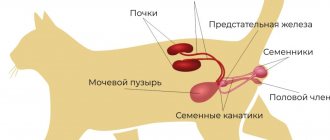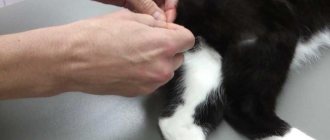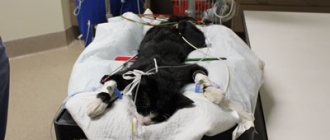After sterilization, the correct recovery of the cat from anesthesia is important. There are several types of anesthesia. The owner should know whether the drugs harm the body, how long their effect lasts, and how awakening occurs. The owner should also be prepared for possible complications, know how to act, and when the pet completely recovers from the effects of anesthesia.
According to veterinarian O. Gerasimenko, problems after surgery arise in weakened and chronically ill animals, and the worst reaction to drugs occurs in white cats.
How long does it take for a cat to recover from anesthesia?
The operation is performed in a clinic or at home. The animal's behavior seems strange in the first 5 or 6 hours after anesthesia. You can't leave him alone. At this time, the anesthetic effect ends and the animal’s postoperative sutures begin to hurt.
Urinary incontinence occurs, but this phenomenon is temporary and passes quickly. The pet's behavior returns to normal within one or two days. The exact time of residual effect of narcotic substances depends on the type of anesthesia, age and other individual characteristics of the animal. During this period, the pet needs the care of the owner.
What you need to know about sterilization and types of anesthesia
Owners who decide to sterilize a cat in order to avoid the appearance of random offspring are very worried not only about how the operation will go, but also how long it will take for the cat to recover from anesthesia.
Important! Sterilization of animals is carried out in a veterinary clinic or at home under general or combined anesthesia.
The choice of anesthesia depends on the type of surgery performed. The veterinarian takes into account the age, individual, physiological characteristics of the animal’s body.
Before sterilization, the veterinarian can choose one of the following options:
- Ovariectomy. Surgery involves only removing the ovaries. The uterus remains in the peritoneum.
- Ovariohysterectomy. Removal of all organs of the reproductive tract (uterus, ovaries).
- Tubal ligation (tubal occlusion). After this operation, even if an accidental mating occurs, pregnancy will not occur and the cat will not bear offspring.
Depending on the type of surgical intervention, the choice of one or another anesthesia technique depends. In modern veterinary medicine, outdated drugs, which were previously equated to narcotic drugs, are not used. Therefore, the harm to the body after anesthesia for the body of caudate patients is minimal.
But still, one should not exclude possible complications, since even if the correct dosage is observed, the body may react differently to the administration of anesthetics.
In most cases, general anesthesia is used during sterilization, which is often supplemented with local anesthesia to enhance the effect of pain relief. After the operation, you can leave the cat in the clinic for several days or take your pet home approximately 30-40 minutes after the operation.
Features of inhalation anesthesia
Inhalation anesthesia is the sound sleep of an animal (general anesthesia), which is achieved due to gaseous substances entering the respiratory tract in certain doses and concentrations.
From the respiratory tract, through the pulmonary circulation, the drug used enters the brain, gently inducing reliable, controlled sleep.
Thus, the volatile substance used does not enter the systemic circulation, which means that inhalation anesthesia cannot have a negative effect on the internal organs of the abdominal and pelvic cavities.
Upon completion of the gas supply, the drug easily leaves the parts of the brain in a matter of minutes, then returns through the pulmonary circulation to the lungs and is exhaled outward.
Therefore, after such anesthesia, the animals are taken home in full consciousness. After just a couple of hours, the pet moves confidently, leads its normal lifestyle and may ask for food.
Little patient at an appointment with a veterinarian-anesthesiologist
Hence the conclusion: the volatile drug used does not linger in the animal’s body, and therefore does not cause serious consequences during the recovery period. This fact minimizes the time spent on care and makes it easier for the owner to care for the pet.
Cat behavior after anesthesia
The cat does not eat or drink after sterilization
Anesthetic agents for anesthesia are distinguished by their ability to penetrate the brain. They induce sleep and relieve pain throughout the body. But there is a high probability of minor or extensive damage to neurons in the central nervous system. This may lead to temporary or permanent changes in behavior.
You need to keep your cat safe while walking.
If only part of the brain is affected, the cat's behavior may become aggressive. He will lash out at people to whom he was previously affectionate. He will not allow him to be touched, stroked, or fed. But all these actions are completed when the rehabilitation period is completed.
In addition to the effects on the central nervous system, changes in behavior may be due to severe pain. Therefore, for the first few days after completion of the operation, it is recommended to give systemic painkillers in the form of tablets. This will significantly reduce the load on the cat’s body, allowing it to sleep, relax, and recover.
If your cat's behavior does not return after a laparoscopic procedure with systemic anesthesia, a large portion of the brain has been affected. Some breeds are prone to similar phenomena. Their body is weak, so any toxic influence will cause some damage to the brain. It is impossible to do anything with such an effect.
Castration and sterilization are quick procedures that lead to the intended effect. But subsequently complications may develop that will lead to a deterioration in the patient’s well-being. Recovery from anesthesia is difficult for many animals, so the owner must help recover after the procedure.
Video
How cats recover from anesthesia after castration - features of the condition
The process of recovery from anesthesia is individual. Some pets behave aggressively, others wake up slowly and remain lethargic for a long time. An inexperienced pet owner runs the risk of being bitten or scratched.
The side effect of drugs is prolonged disorientation in space and impaired coordination of movements. To prevent the consequences of physical activity, the cat is placed in a place from which it cannot fall. The best option is to leave it in a carrier for a while, in a warm, dry place without drafts and away from heating radiators.
Be sure to read: Complications after castration of a cat: causes, types, symptoms and treatment, when you need to see a doctor
The effect of anesthesia on a cat's body
Anesthesia is the introduction of an animal’s body into artificial sleep using a drug. This occurs due to inhibition of the work of the cortical centers of the brain. Gentle drugs can reduce general or local sensitivity. Such drugs have a relatively gentle effect on the brain.
Anesthesia is an exposure to a toxin, and therefore has a destructive effect on cardiac structures and nerve fibers. In most cases, this causes hallucinations, visual and auditory disturbances, sleep disturbances and headache attacks. Mild side effects disappear 3-5 hours after using painkillers.
Operations are performed with caution in the presence of heart disease. Some drugs can affect the conduction system, which causes arrhythmia. In most cases, the effects disappear after a few days. In the presence of underlying chronic pathologies, the cat takes a long time to recover from anesthesia after castration.
What is anesthetic risk?
No matter how experienced the surgeon and anesthesiologist are, there is always the possibility of complications, even death. Anesthesia for cats is a serious burden primarily on the cardiovascular and respiratory systems. Minimizing anesthetic risks is the task of the veterinarian, who is obliged to individualize the standard regimen taking into account the characteristics of a particular cat. In many cases, the serious condition of a cat after anesthesia is a consequence of the use of drugs “at random”, without studying the condition of the mustachioed patient. To avoid problems, it is important to contact only competent specialists with an excellent reputation.
Options for helping you recover from anesthesia
To help the animal, it is recommended to use an integrated approach aimed at normalizing the body’s condition.
- Give more liquid. If your pet drinks water, the renal system works more actively, removing urine. Together with it, toxic substances and active anesthetic components of anesthesia are eliminated.
- Eliminate exposure to any stress. During the first few days, it is forbidden to touch the animal or play with it. This is especially true for families with small children. The cat needs more sleep to gain strength for physical recovery.
- Normalize the ambient temperature. The pet should not be hot. You can leave the window open to let in cool air. When oxygen enters the brain, the negative effects after anesthesia penetrates are eliminated.
- Balanced diet. It is not recommended to change food immediately after surgery, as the pet may refuse it, which will lead to a sharp weight loss and loss of strength. You can add other ingredients to your regular food. For example, lean beef, cottage cheese, and milk are good during this period in addition to dry food, which contains all the vitamins.
- Give medications prescribed by the doctor. It is usually an anti-inflammatory and antibacterial agent. It is recommended to treat the wound with antiseptic solutions, this can be hydrogen peroxide, chlorhexidine, brilliant green. Treatment will help the wound heal faster and prevent various complications.
- Anesthesia. Veterinarians recommend giving painkillers in the first 5-6 days after laparoscopic surgery so that the cat can better tolerate the wound healing period. This is very painful and can cause sudden mood swings.
- Antipyretic medications as needed. If body temperature rises during the rehabilitation period, this may be normal if the period is short. The animal is given mild antipyretics that do not have a toxic effect on the liver.
- Use of multivitamins. If a blood test reveals a decrease in vitamins, minerals and microelements, multivitamins may be prescribed during the pet’s rehabilitation period. They increase the metabolic process, which leads to increased regeneration of damaged tissue.
Dog after anesthesia: how long and how it goes away
You can help in different ways. But in order to completely protect the animal from negative influences, follow the doctor’s recommendations.
After 2-3 weeks, it is recommended to come back for an appointment so that he can examine the connective tissue scar formed after the operation. If there are no complications, the prescribed medications are gradually withdrawn.
Attention! The behavior of an ordinary cat after anesthesia and its health quickly return to normal if it does not experience stress, eats well, and drinks clean water.
How to behave when a cat recovers from anesthesia, what to do?
The first three days of the pet should not be lost sight of. You need to monitor the healing process and do not let the cat lick the wound. Otherwise, infection and purulent inflammation are possible. To prevent licking, wear an Elizabethan collar. The seams are treated with products recommended by the veterinarian. If the cat quickly came to his senses, the wounds do not bother him, and they should not be treated again.
Clean water should be nearby at all times. If the animal wants to drink, but cannot do it, you need to wet the mouth with a syringe or pipette, but do not inject it forcibly. You cannot feed your pet on the first day.
An empty tray without filler is placed next to the convalescent person so that the animal does not clog the wound. The toilet should be cleaned daily, or even better after each visit. If the first bowel movements do not occur in the tray, there is no need to punish. It may be painful for a cat to climb. When the condition returns to normal, the habit of going to the toilet will be restored.
If a cat is soiled with urine, it should not be bathed. You should use refreshing wipes.
How long does the operation take?
As a rule, castration of a cat takes place very quickly: literally in 10-20 minutes. It takes much more time to prepare for it. During the operation, the testes responsible for the production of sex hormones are removed. The veterinarian makes thin incisions through which he removes them. If the pet owner is present for the operation, the doctor may show the extracted testes to prove that the operation was successful.
Many cat owners feel remorse because they have deprived their pet of its privacy, made it inferior, and practically an undercat. It would be a huge mistake to think so. Castration deprives the cat of interest in the tailed representatives of the fair sex and the possibility of reproduction - but that’s all!
Think about how many uncastrated cats die under the wheels of cars and in the teeth of stray dogs, how many fall from balconies and loggias when, obeying the call of ancient instinct, they go in search of a partner! Painful death or serious injury – would you really want such a fate for your pet? Of course not. So put all your regrets aside and give your pet maximum attention while he recovers from surgery. By doing this, you will further strengthen his affection for you, and you yourself will be able to atone for your completely groundless guilt before him for the damage caused - and, by the way, greatly exaggerated! – suffering.
Inhalation anesthesia for rodents and ferrets
The most delicate pets at Alisavet are given inhalation anesthesia.
All three stages of creating gas anesthesia are carried out on these animals. However, there are small peculiarities here.
Inhalation anesthesia for small rodents is also carried out after premedication. In hamsters and rats, a tube is not inserted into the trachea, so the gas mixture enters through a special mask.
Ferrets and large rodents (guinea pigs, rabbits) are first given premedication, after which an intravenous catheter is installed, and then a gas mixture is also supplied using special masks.
03/09/18 Anesthesia for rabbits. Inhalation (gas) anesthesia
Cat's reaction to anesthesia
Immediately before the operation, before the introduction of anesthesia, it is possible to administer special sedatives. This is usually done to minimize stress on the animal. The most commonly used anesthetic drug is Propofol, but other drugs can also be used. The time it takes for a cat to fall asleep after the administration of an anesthetic may vary; it ranges from 10 to 30 minutes.
In addition to anesthetics, muscle relaxants are also used to immobilize cats, which promote additional muscle relaxation. To assess the cat's condition, it is connected to special sensor devices. This allows you to promptly notice any deviations and correct actions if necessary. The cat can remain under anesthesia from one to three hours, depending on the complexity of the operation.
Cat after anesthesia: 6 signs that should alert the owner
A conscientious owner takes a vacation while caring for a neutered cat. Despite the simplicity of the operation, your pet may experience complications for a number of reasons.
The following are symptoms that may require veterinary attention:
- Low or high body temperature. The norm for cats is from 37.5 to 39.0 °C. The veterinary surgeon who performed the operation will tell you how often you need to measure your temperature. The problem is that anal measurement is painful. Therefore, purchase an ear or non-contact thermometer. The costs will pay off, since the need for thermometry will arise more than once during your life.
- Refusal to drink for a day and food for more than three days. If the cat does not drink, the concentration of salts in the urine will increase, which can lead to sedimentation and the onset of urolithiasis. Some cats may go 3 or more days without drinking when fed wet, prepared, canned food or natural food. But after the operation, a day is considered an acceptable period. Perhaps refusal to drink indicates intoxication, in which vomiting occurs when food or water enters the stomach. A healthy cat can go without food for 5 days. But, for the speedy healing of wounds, the operated pet needs nutrients. On the second day, a third of the feed is given from the norm, and at the end of the week the consumption is brought up to the recommended value.
- Stiffness in movements due to a feeling of interference in the perineum. This may be due to swelling of the sutures, but it is dangerous to act at your own risk.
- Pain when stroking the abdomen. Probably, the infection entered the abdominal cavity during the operation, or after it with a sudden movement, peritonitis develops
- Painful and difficult urination , accompanied by a plaintive meow.
- Dehiscence of the suture, bleeding for 2-3 days or the appearance of purulent discharge.
Be sure to read:
A sterilized cat asks for a cat: reasons, when it is the norm, what to do, how to avoid
General information about castration
Castration is an operation to remove the testicles in a male and the ovaries and uterus in a female. The procedure is always performed under general anesthesia, as it involves dissection of the scrotal tissue. However, general anesthesia is a broad concept, since it can use different drugs and approaches.
Note! Castration and sterilization are different concepts. Castration removes the reproductive organs and neutering is a method of rendering an animal infertile.
The classic method of castration involves minimally invasive intervention. Typically, the operation takes 10–15 minutes. During this time, the veterinarian makes an incision along the white line of the scrotum and, with gentle pressure, pushes the testis out. Next, the veterinarian pulls out the spermatic cord and:
- He cuts it, having previously bandaged it below the incision site.
- He ties it with a knot and cuts above it.
- He burns the tissue with special forceps (similar to a hair curling iron) and cuts the cord in the “dried” gap.
The same procedure is repeated on the second testis. In theory, everything looks complicated, but in practice the procedure happens quickly. Any veterinarian can perform castration, or rather, such a procedure does not require much experience. However, we recommend that you entrust your pets only to experienced doctors, since any intervention may result in complications.
To eliminate the risks associated with anesthesia and rehabilitation, it is necessary to examine your pet before castration. If you go to the clinic for a preliminary consultation, the doctor will most likely prescribe a set of standard procedures.
Blood tests - general and detailed. A general blood test shows the level of hemoglobin, leukocytes, and erythrocyte sedimentation rate. Biochemical analysis is usually taken for liver parameters. If hemoglobin is low, before castration, the cat is treated for anemia. If the level of leukocytes is higher, a virus or infection is already raging in the pet’s body, which needs to be cured before surgery. Rapid sedimentation of erythrocytes indicates that the cells that carry oxygen throughout the body are dying. There are many reasons for this phenomenon, but they need to be identified and eliminated before castration.
Liver tests reflect the condition of the liver, or more precisely, its ability to cope with abnormal load. Almost all drugs that are administered before and after surgery will be removed (filtered) from the blood by the liver.
Is it necessary to use general anesthesia for dogs and other animals?
Knowing the serious consequences, you always want to bypass general anesthesia, namely, make it local - acting in a specific part of the body. But, this is only possible for minor procedures: stitching up the skin for minor damage, removing a tiny growth, or trimming an ingrown claw.
But before sterilization, it’s definitely not possible to do only epidural anesthesia. Animals are not people, and they certainly will not lie motionless until the end of the operation. And the reason for this is fear.
And it will also not be possible to properly brush your teeth without general anesthesia - the pet is so stressed that not a single local anesthesia will keep a panicking animal on the doctor’s table.
Therefore, for operations and many procedures, pets need to use general anesthesia, and sometimes complex.
Positive aspects of the operation
Those owners of domestic cats who have finally decided to neuter their pet often ask whether there are any positive aspects to this operation. In fact, there are quite a few of them:
- the cat stops marking its territory (in some animals this function does not completely disappear, but marks appear much less frequently, and their smell becomes less pungent);
- cat “concerts” are stopped;
- the animal becomes calmer, aggression disappears;
- friendly relations are established between him and other animals in the house;
- the cat, having lost interest in the opposite sex, becomes more attached to the owner and plays with children with great pleasure.
Obesity, which so often accompanies castration, is not at all inevitable. This is not a complication or a consequence of the operation, but just errors in nutrition - by the way, easily eliminated.
In order for your pet to remain in excellent shape after castration, do not neglect the advice of veterinarians: fewer calories and more exercise. Health to you and your pets!
How long can a cat have a fever after castration?
After castration, as after any surgical intervention, it is necessary to monitor body temperature. In the first hours it may drop below 37 °C. This is explained by stress, blood loss, and slowing of metabolism under the influence of anesthesia. The cat may shiver, so it should be well wrapped.
The advice to cover your pet with heating pads is questionable, as it promotes bleeding. The temperature should return to normal within 24 hours. If hypothermia continues for the second day, you should inform your veterinarian.
But, on the first day the temperature can rise to 40 °C. If no other pathological symptoms are noticed, there is no need to worry. But when a pet has a fever 4 or more days after surgery, veterinary care is necessary: an inflammatory process develops. You should not give your cat antipyretic medications, since their effect on humans and cats is different.
Rules of care, transportation and rehabilitation
Regardless of the reason that prompted the owners to castrate their pet, you will need time for subsequent care for the cat.
This includes:
- The immediate postoperative period, when the cat recovers from anesthesia and the effects of sedatives;
- Observation of the incision and treatment of sutures, if any;
- Continue to comply with the veterinarian’s instructions after the stitches are removed and the animal is fully restored.
When agreeing to an operation for medical reasons, when intervention is required to preserve the health and life of the pet, in addition to the standard set - monitoring the cat’s condition, treating the suture - one will have to carry out complex treatment along with the underlying disease.
Why is cat rehabilitation needed after castration?
First of all, the rehabilitation process is aimed at identifying and preventing possible complications. Under the influence of anesthesia, a cat's self-regulation is disrupted; the pet is in an unconscious state or semi-conscious, when it cannot control the functioning of the muscles, the excretory system, and does not orient itself in space.
Body temperature drops sharply, additional heating is required, plus anesthesia causes a strong feeling of thirst. For several hours after surgery, the animal should recover from the effects of the medications, preferably under your supervision, as disturbances in the excretory and respiratory systems may occur.
If the animal is taken home immediately after surgery, the owner should have the doctor's contact phone number in case the pet's health worsens.
Rehabilitation involves creating conditions for the favorable and speedy restoration of the animal’s health. Preventing hypothermia, timely treatment of the suture, and preventing wound licking will protect your pet from the need for additional drug treatment.
How to transport a cat after surgery?
The most reasonable option is carrying. This is convenient for both the owner and the animal. A flat bottom will provide a comfortable position for the body, and, therefore, will minimize the risk of touching the incision, pushing, or inadvertently squeezing the blood circulation in the limbs. The walls of the carrier will provide the animal with shelter from light and the flickering of foreign objects. Ideally, if the veterinary clinic is far from home, take the cat by car or call a taxi. Public transport in this case can become a source of additional stress.
- Be sure to lay a warm, hygroscopic fabric on the bottom. The bedding should provide warmth to the animal and, if necessary, absorb liquid - the cat may wet itself because it does not control the bladder;
- The cat needs to be covered with a warm diaper or towel to keep warm;
- Place a heating pad on the side of the animal, but at a distance from the surgical suture, so as not to provoke bleeding.
If it is possible and the top of the carrier can be removed, then when you bring it home, you can leave it in place, opening it for observation. Or carefully place it on a flat surface (ideally on the floor), ensuring there are no drafts and a source of heat.
To avoid all this, you can simply call a veterinarian at home, then you will not need all the above-described manipulations!
Important Takeaways
Some operations are performed only once in a lifetime (sterilization of a dog, sterilization of a cat, castration of a male or female cat), so let this surgical intervention be carried out in excellent conditions and with fully controlled anesthesia.
Take the time to find a veterinary clinic that offers gas anesthesia, and don’t skimp on traveling if the chosen facility is far from you. It's worth it!
Easy awakening after inhalation anesthesia
And if any procedure (for example, brushing teeth) or surgery (for injuries and other pathologies) must be performed more than once for forced reasons, then choosing inhalation anesthesia at some point may simply save the life of your cat or dog.
What does a cat look like after surgery?
Many owners of pet cats, especially those unprepared for such a spectacle, are horrified by the sight of their pets having just undergone surgery. No surprise! A cat often lying motionless, with eyes wide open, breathing intermittently is not a sight for the faint of heart. And if his paws also twitch slightly in convulsions, then the owner may even be frightened and decide that he is losing his pet.
Do not worry! This reaction of the body is considered completely normal, any veterinarian will confirm this to you.
Abnormal stool
After surgery, the cat's intestinal function may be disrupted and constipation or diarrhea may appear, which is accompanied by pain and brings additional suffering to the animal. You need to pay attention to the following signs:
- refusal to eat;
- plaintive meow;
- absence of acts of defecation;
- periodically appearing trembling of the back of the body.
If your cat is constipated, you need to purchase a laxative for her on the recommendation of a veterinarian and change her diet. At home, you can use regular Vaseline.
Diarrhea occurs after exposure to toxins contained in anesthesia . In this case, the cat should limit drinking and feeding and use medication prescribed by the veterinarian. At home you can drink rice water.
© shutterstock
What signs should alert the owner
In the vast majority of cases, castration of a cat takes place without any consequences. However, it is worth remembering three very dangerous symptoms that should alert you:
- increased body temperature on the third day after surgery;
- lack of appetite in the first three days after surgery;
- the presence of inflammation, slight bleeding or discharge from the sutures.
All these signs may indicate a developing complication, which only an experienced specialist can identify and provide qualified assistance.
Sterilization and post-operative care of a cat
Sterilization (castration) operation – if you decide to have a sterilization operation for your pet, we suggest that you familiarize yourself with the recommendations for caring for your cat after the operation, because the postoperative period is the most important, and it falls on your shoulders. After the operation, the veterinarian must tell you about all the intricacies of caring for the animal after anesthesia.
Read: Sterilizing a cat
Here is a list of our recommendations that will definitely be useful to you.
Prolonged recovery of the cat from anesthesia
In rare cases, a cat may not recover from anesthesia for a long time after surgery. Lethargy, drowsiness, depression, refusal to feed, unstable temperature are a characteristic condition that accompanies animals after anesthesia.
But if the animal does not return to its normal life for a long time, it is possible that, for one reason or another, postoperative complications have developed, including:
- Post-anesthetic hyperthermia. After anesthesia, in the first 3-8 hours, body temperature may be slightly lowered, but not more than 0.5-1 degrees. The cat's body, earlobes, and paw pads are cold to the touch. Mucous membranes are pale. Breathing is shallow and rare. Heart rhythm is disturbed.
- Temperature increase. This condition is diagnosed if the cat has a fever and the readings do not stabilize on the third day.
- Internal bleeding.
- Acute allergic reaction to the action of drugs used for anesthesia.
Possible complications also include infection of the postoperative wound with pathogenic flora, suppuration of the scar, and swelling around the suture. This condition is most often noted if the cat licks the wound, tries to chew it and remove the stitches on its own.
If the cat’s temperature has increased or decreased significantly, the mucous membranes are blue, pale, the animal does not come out of narcotic sleep within 20-24 hours, it is suffering from debilitating vomiting, and coordination of movements has not been restored after 48 hours, immediately contact your veterinarian.
First hours
The first days of the postoperative period are considered critical, during which the owner must monitor the cat’s condition. When you arrive home, you need to place your pet on the floor in a quiet place, away from heating radiators and drafts. You should not place a sleeping cat on the bed; it may fall and hurt itself.
Typical cat behavior after anesthesia is a cocktail of mixed negative emotions. Gradually coming to its senses, the cat looks deeply unhappy, constantly tries to go somewhere, staggers, has difficulty holding its head up, crashes into walls, and cannot get into the doorway. It’s painful and scary to watch, your heart aches with pity, but it’s important to pull yourself together and realize that all this is the norm. Until muscle tone is restored, you need to hold your pet, not allowing it to wander around the apartment or jump on the furniture: affection, quiet conversations and light stroking will certainly help, unless the pet shows aggression.
Sudden aggression in a cat after anesthesia is also normal. The pet is disoriented, her paws do not obey her, it is difficult to concentrate, calculate the distance, and it is difficult to assess the situation as a whole. The cat is frightened, tries to climb higher or hide deep under the bed, and the owner not only does not allow her privacy, but also constantly climbs with a thermometer, feels her nose, ears, and intrudes in every possible way. How can you not get angry? To reduce emotional pressure, you should close the curtains, ask your family to be quieter and once again not approach the cat, observing its actions from the side.
Coming out of anesthesia
Usually, the operated animal is discharged from the veterinary clinic only after waking up, but sometimes it is more convenient to pick up the cat immediately after the operation in order to transport it home while it sleeps. In any case, keep in mind that anesthesia lowers body temperature, so your cat will need warmth after surgery.
. If you plan to pick her up right away, place additional bedding on the bottom of the carrier and prepare a blanket in advance. Sometimes a heating pad may be needed. If the owner does not have one, you can use a plastic bottle with warm water wrapped in a diaper.
After receiving the sleeping cat from the hands of the veterinarian, lay it on its side and cover it with a blanket.
The eyes of a cat under anesthesia may be slightly open. This is fine. To prevent the cornea from drying out, you can occasionally instill saline, artificial tears, or gently close the cat's eyelids with your fingers. When the animal begins to wake up, the blink reflex will be restored. /p>
Do not rush to leave the veterinary clinic: it is safer and more reliable to wait for the cat to completely recover from the state of anesthesia under the supervision of a veterinarian. Once you get home, place the cat on the floor, on a bedding or bed, in a warm, quiet place, away from doors and drafts.
Place the litter tray close to the bed.
Anesthesia and anesthesia - 14 frequently asked questions
14 frequently asked questions about anesthesia and anesthesia General anesthesia - with this form of anesthesia, they sleep deeply, soundly and safely. Her response to pain is as repressed as her consciousness. Anesthetics are constantly supplied through the blood or breathing air. Therefore, this anesthesia is well controlled. Can be used in any surgery. (Masking anesthesia, laryngeal mask, anesthesia and intubation anesthesia) Regional anesthesia - covers a specific part of the body, depending on the plant. They remain conscious during the procedure or optionally choose twilight sleep, which includes spinal cord anesthesia (ankle and back anesthesia) and upper and lower limb locking. (Plexus anesthesia, knee block, etc.) Local anesthesia only makes a small part of your body insensitive to pain. This anesthesia procedure is performed by the surgeon himself.
What needs to be done before anesthesia?
Please tell your anesthesiologist about all the medications you are taking, including those you bought at the pharmacy! It is especially important to be sober, not to eat 6 hours before surgery and not to drink liquids 2 hours before surgery! (Exception: a few sips of water for taking important medications - but you should definitely check this with your anesthesiologist!)
On the day of anesthesia, refrain from smoking!
Remove makeup and nail polish!
Jewelry - including piercings - must be removed! In addition, glasses, contact lenses and hearing aids, as well as removable parts of teeth, as well as other prosthetics. Exceptions are possible only after consultation with an anesthesiologist.
Why can't you eat and drink before surgery? Anesthesia eliminates protective reflexes (such as automatic swallowing). As a result, there is a risk of stomach contents entering the pharynx and then into the respiratory tract. This can lead to severe pneumonia. The risk of swallowing (aspiration) increases the shorter the last meal. Therefore, it is in your best interest to tell the anesthesiologist exactly when you last ate and drank.
Why can't I smoke on the day of surgery? Smoking may increase stomach acid secretion and therefore has the same risk as eating before surgery. Stomach juice can drain back into the esophagus and into the lungs (aspiration), causing pneumonia there.
What are the risks and complications of general anesthesia?
- Nausea after surgery (usually caused by drugs). It only occurs in patients with a certain predisposition and can be treated very well with medication.
- Hoarseness (after intubation) usually resolves within 24 hours.
- Aspiration (which means foreign bodies entering the trachea or lungs when swallowed). If the patient adheres to the prescribed preoperative behavioral rules (“sober”!), aspiration is practically impossible. This hazard is most common in acute procedures (unplanned surgeries).
- Cardiovascular disorders (dangerous in pre-existing cardiovascular diseases) can be caused by the stress of surgery.
- Cooling (today very rare: during surgery the patient is warmed up accordingly) is manifested by postoperative tremor.
- Damage to teeth can occur during intubation - but is very rare.
- Malignant hyperthermia (extremely rare, 1:250,000, but life-threatening) is caused by the patient's genetic predisposition. This complication begins with a significant increase in body temperature and can lead to kidney failure. If there is a known history of malignant hyperthermia in the family, be sure to tell your anesthesiologist!
How quickly does anesthesia work? Whether the anesthesia begins through the bloodstream or the breathing air, you will fall asleep within seconds.
Is it possible to wake up during surgery or hear something? After you fall asleep, your anesthesiologist constantly checks the depth of anesthesia in addition to vital organ functions. With the medications available today, especially gaseous anesthetics, you can almost completely eliminate the possibility of waking up or listening during surgery. In addition, modern devices make it possible to measure the depth of anesthesia.
Will there be any pain after the operation? About 25% of patients complain of nausea after surgery. Reasons include personal predisposition (eg, motion sickness), type of surgery, and ultimately the anesthesia procedure chosen. You can counteract nausea with preventive medications. Although nausea cannot be completely avoided, it is less frequent and milder.
When can I eat and drink again? Depending on the type of operation, this time interval can vary greatly. It is best to wait at least 3 hours to drink and feed solid food for at least 6 hours.
Will there be pain when waking up after anesthesia? No. Although pain cannot be completely avoided after surgery, you will, of course, be given appropriate pain therapy both during the recovery phase and afterwards. The need for painkillers mainly depends on the operation being performed.
When can you go home after general anesthesia for an outpatient procedure? Discharge should always be carried out by the surgeon and anesthesiologist no earlier than 2 hours after the operation. The patient is again warned about the need to drive a vehicle during the first 24 postoperative hours, enter into any contracts, or take alcohol or sedatives (except for prescribed medications).
What is regional anesthesia? Regional anesthesia is the temporary loss of sensation of pain in a specific area of the body due to interruption of pain transmission to the brain. Typically the patient remains conscious during this form of anesthesia.
What types of regional anesthesia are there? Interruption of anesthesia is possible in several places: In the area of the spinal cord (“cross stitch”) In the area of the nerve plexus (plexus), that is, where the nerve fibers merge with the nerves after leaving the spinal cord (plexus of anesthesia) In the area of individual nerves (so called peripheral regional anesthesia or peripheral nerve blocks)
Spinal and epidural anesthesia. Both are regional spinal cord anesthesia procedures. The difference between the two methods is the depth of penetration. Unlike spinal anesthesia, with epidural anesthesia, the height of the puncture site and the amount of local anesthesia determine the location and size of the anesthesia area. "Regional anesthesia" occurs because only a specific part of the body, the "spinal cord," is anesthetized because the nerves coming out of the spinal cord are anesthetized. Unlike general anesthesia, the patient is conscious during the operation.
Spinal anesthesia can be used for all operations below the navel, that is, for operations on the legs, pelvis, perineum and lower abdomen. With epidural anesthesia, operations can be performed on the upper abdomen, pelvic and genital areas, and on the legs. Spinal anesthesia is a safe procedure using modern, state-of-the-art equipment. As with any method, complications are sometimes possible, but they are usually temporary. Permanent damage is extremely rare.
Are you awake during surgery under local anesthesia? Depending on the patient's wishes, this may be awake. But if he prefers to sleep, he can be given a mild tranquilizer.
Does the patient have to be sober before local anesthesia? As with general anesthesia, the same rules of conduct apply to regional anesthetics.
Sources:
- Anesthesiology. National leadership (ed. A.A. Bunyatyan, V.M. Mizikov). M., ed. Group "Geotar-Media". 2011.
- Levshankov A.I. Ensuring patient safety (monitoring) during anesthesia, resuscitation and intensive care. Guide to anesthesiology and resuscitation (ed. Yu.S. Polushin). St. Petersburg - 2004. – pp. 137-139
- Likhvantsev V.V., Ulitkina O.N., Rezepov N.A. Postoperative delirium: what new does the new ESA-2017 guideline offer us? // Bulletin of Anesthesiology and Reanimatology. - 2017; 14(2): 41-47)
- General anesthesia. In the book: Anesthesiology and resuscitation. Textbook for training highly qualified personnel, vol. 1 (S.A. Sumin, K.G. Shapovalov). Moscow: Medical Information Agency, 2022. P. 257-286;
- Terminology and classification of anesthesia methods. In the book: Guide to anesthesiology and resuscitation (ed. Yu.S. Polushin). St. Petersburg, 2004. Pp. 279-282
- Continuum of depth of sedation: Definition of general anesthesia and levels of sedation/analgesia. Committee of Origin: Quality Management and Departmental Administration (Approved by the ASA House of Delegates on October 13, 1999, and last amended on October 15, 2014)
During what period can an animal leave?
On average, the operation takes 40 minutes. The rest of the time is spent on restoring the pet. And if we talk about how long a cat will be sick after sterilization, then the period is determined based on the type of anesthesia.
The following are distinguished:
- Muscle relaxant and analgesic. A popular mixture used by most veterinarians. It is considered the most effective among those available, but the main disadvantage is the difficult recovery period. The animal may feel unwell throughout the day.
- Muscle relaxant and epudral anesthesia. Only experienced specialists are allowed to use this mixture. Any error in the pattern can lead to atrophy of the hind legs. The ability to move them will return, but for about two days the pet will move exclusively by crawling. If anesthesia is performed correctly, the body will recover within 8 hours, which is a plus.
- Gas and inhalation. High efficiency and minimal toxicity are the advantages of this option. When choosing this anesthesia, the owner does not have to worry about the pet’s condition, since he will come to his senses almost immediately after the operation is completed.
What affects the cat's condition after surgery?
A week is an average indicator, and you should not rely only on it. Some pets have a hard time with any type of surgery, and some begin to run already on the second day.
Among the signs affecting the cat's condition are:
- Age. The older the animal, the more difficult it is for it to withstand the intervention of a surgeon;
- Type of procedure. For example, if the surgery is an emergency, recovery may take longer;
- Type of anesthesia. Some medications may make the kitten's condition worse.
Thus, when thinking about the question of how long a cat is sick after sterilization, it is worth taking into account the factors listed above and drawing a conclusion.











